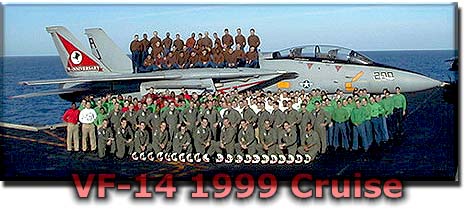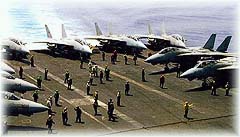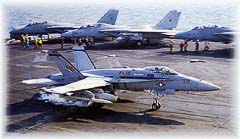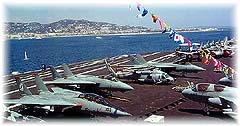Coming HOME!

Six months at sea ... The first ever
deployment to see a Carrier and an Air Wing participate successfully in TWO theaters ... Mission accomplished time and time again. VF-14 is now coming
HOME.
 On
Tuesday, September the 21st the Tomcats of Fighting Fourteen roared
again in the Oceana skyes. CVW-8 aircrew came back from deployment to the loved ones whose
long waiting thus came to an end. On
Tuesday, September the 21st the Tomcats of Fighting Fourteen roared
again in the Oceana skyes. CVW-8 aircrew came back from deployment to the loved ones whose
long waiting thus came to an end.
For two months over Kosovo, old rivalries between the fighter crews
were put on hold. F/A-18 Hornet pilots stopped calling their buddies in F-14 Tomcats
dinosaurs. The Tomcat pilots and radar-intercept officers quit boasting that their older
planes still get more done than any Hornet.
 Through
thousands of combat missions, the two camps forged a partnership unmatched in previous
deployments -- what Navy leaders have taken to calling the ``hunter-killer'' team. Through
thousands of combat missions, the two camps forged a partnership unmatched in previous
deployments -- what Navy leaders have taken to calling the ``hunter-killer'' team.
Though combined they made up 10 percent of the strike aircraft in
the operation, Hornets and Tomcats flying from the carrier Theodore Roosevelt dropped a
third of all the precision bombs in the NATO campaign that drove Serbian troops out of
Kosovo.
 On
Tuesday, what one F/A-18 pilot called ``the most effective team in the theater'' fittingly
came home together to Oceana Naval Air Station, a day ahead of their carrier's return to
Norfolk. On
Tuesday, what one F/A-18 pilot called ``the most effective team in the theater'' fittingly
came home together to Oceana Naval Air Station, a day ahead of their carrier's return to
Norfolk.
Forty-six planes -- two squadrons each of Hornets and Tomcats --
roared in, their aviators hailed as heroes by hundreds of family members and friends.
It was the largest fly-in in many years at Oceana and the first time
F/A-18 squadrons came home there from a deployment. All of the other Hornet squadrons now
based at Oceana transferred there earlier this year from Cecil Field, Fla.
Though the carrier air wing suffered no losses, the returning
aviators said Serbian anti-aircraft artillery fire was a frequent threat. ``We all felt in
danger,'' an Aviator said, ``but at the same time, we didn't feel unprepared. We train
from Day One to do what we did.''
Capt. Dale ``Sparky'' Lyle, the air wing commander, said the
deployment on the Roosevelt was marked by ``going very fast from one place to another.''
A little over a week after hustling out of Norfolk on March 26, the
carrier was launching air strikes in Kosovo. When its aircraft had finished dropping the
last of its 800 tons of ordnance there two months later, it hurried to the Persian Gulf
and, within days, its planes were bombing Iraqi military targets.
In Iraq, the carrier's planes dropped another 30 tons of bombs.
It was one of only a few times in which a carrier air wing has flown
combat missions in two different military campaigns during the same deployment.
Lyle said the operation ``validated how important it is to have
naval air forces. I think we added a lot to the fight on very short notice.''
For the aviators, the Kosovo campaign will have the longer-reaching
consequences.
For the first time, Tomcats and Hornets worked extensively together
during their sorties. Using their high-power sensors, the two-member Tomcat air crews
helped the Hornet pilots locate targets. In many cases, the Tomcats even laser-guided the
Hornets' bombs to the targets.
``It required a lot of close coordination,'' Lyle said, ``and we
couldn't have accomplished what we did without either one of them.''
Kosovo was the first major campaign in which the Tomcat,
once strictly a fighter plane, was used extensively for bombing. And never before had the
Tomcats hit, as they primarily did in Kosovo, mobile targets such as tanks and armored
personnel carriers.
The F-14s also took on a far greater role in controlling other
aircraft than ever before.
The accomplishments quickly faded to the background on Tuesday,
however, as the aviators reunited with their loved ones. |